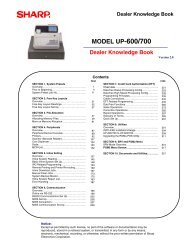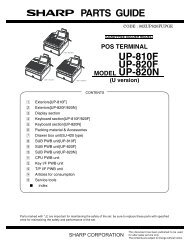ER-A Model - MS Cash Drawer
ER-A Model - MS Cash Drawer
ER-A Model - MS Cash Drawer
You also want an ePaper? Increase the reach of your titles
YUMPU automatically turns print PDFs into web optimized ePapers that Google loves.
Master<br />
Master Reset<br />
Mode Switch (Mode Lock)<br />
Option<br />
Patch<br />
PBLU<br />
PLU<br />
PLU Groups<br />
PLU (Linked)<br />
DOCUMENT<br />
POS/Glossary<br />
This is the controlling unit in an IRC system. The master will have<br />
generally the most memory of the units in the system. It is used for<br />
real-time transmission, to consolidate totals from one or more<br />
registers, to download programming, sending information to a remote<br />
printer, and consolidation of sales data for further processing. For<br />
example, a back office application.<br />
This operation will reset all the totals in the machine. There are three<br />
(3) types of master resets.<br />
MRS-1 (Master Reset-1): Clears the entire available memory<br />
and restores the initial factory default values for the keyboard<br />
and PGM-mode programming.<br />
MRS-2 (Master Reset-2): Clears the entire available memory,<br />
allows free assignment of the ten-key pad, eliminates the<br />
Direct Department and PLU assignments, and restores the<br />
initial factory default values for all other PGM-Mode<br />
programming.<br />
MRS-3 (Master Reset-3): Clears the entire available memory,<br />
allows the input of the product serial number and the<br />
assignment of the ten-keypad, eliminates the Direct<br />
Department and PLU assignments, and restores the initial<br />
factory default values for all other PGM-Mode programming.<br />
This is the control lock of the register. Determines the “Mode” of<br />
operation of the register.<br />
A device or function that can be added to a register. It is usually not<br />
found on the unit out of the box.<br />
A “Patch” is a service function that allows the program in a ROM to be<br />
modified without replacing the chip. It is properly called a SSP. The<br />
first step in a patch is the number of the patch. Leading zeros are<br />
input as part of the patch step. Usually, when several patches are out<br />
for a unit, then a new version ROM will be made available. This new<br />
ROM will incorporate the previous patches issued.<br />
Previous Balance Look Up: This is a guest check system. The guest<br />
check will show the current balance of items ordered, until the check is<br />
“serviced”. It may or may not include tax and a gratuity.<br />
Price Look Up: a PLU is a section of memory where an item is<br />
assigned a number, a name, and a preset price. The machine will<br />
locate this item by number and add the amount to the sale. The price<br />
does not have to be input through the keyboard during a sale.<br />
This is a section of memory where the PLUs are grouped and stored<br />
for reporting purposed. This total is updated on the fly. To see the<br />
amount of sales, an “X” (Read) or a “Z” (Zero out) report has to be<br />
taken.<br />
A Link PLU is used when more than one and up to five items is<br />
registered with one key depression. Each unit price is accumulative<br />
for those PLU items associated to the link type operation and are<br />
printed with the individual unit prices. For example, Bottle Deposits,<br />
specials or messages.<br />
Sharp Electronics Corporation Sharp Academy 2 OF 5<br />
Page 104 of 108





